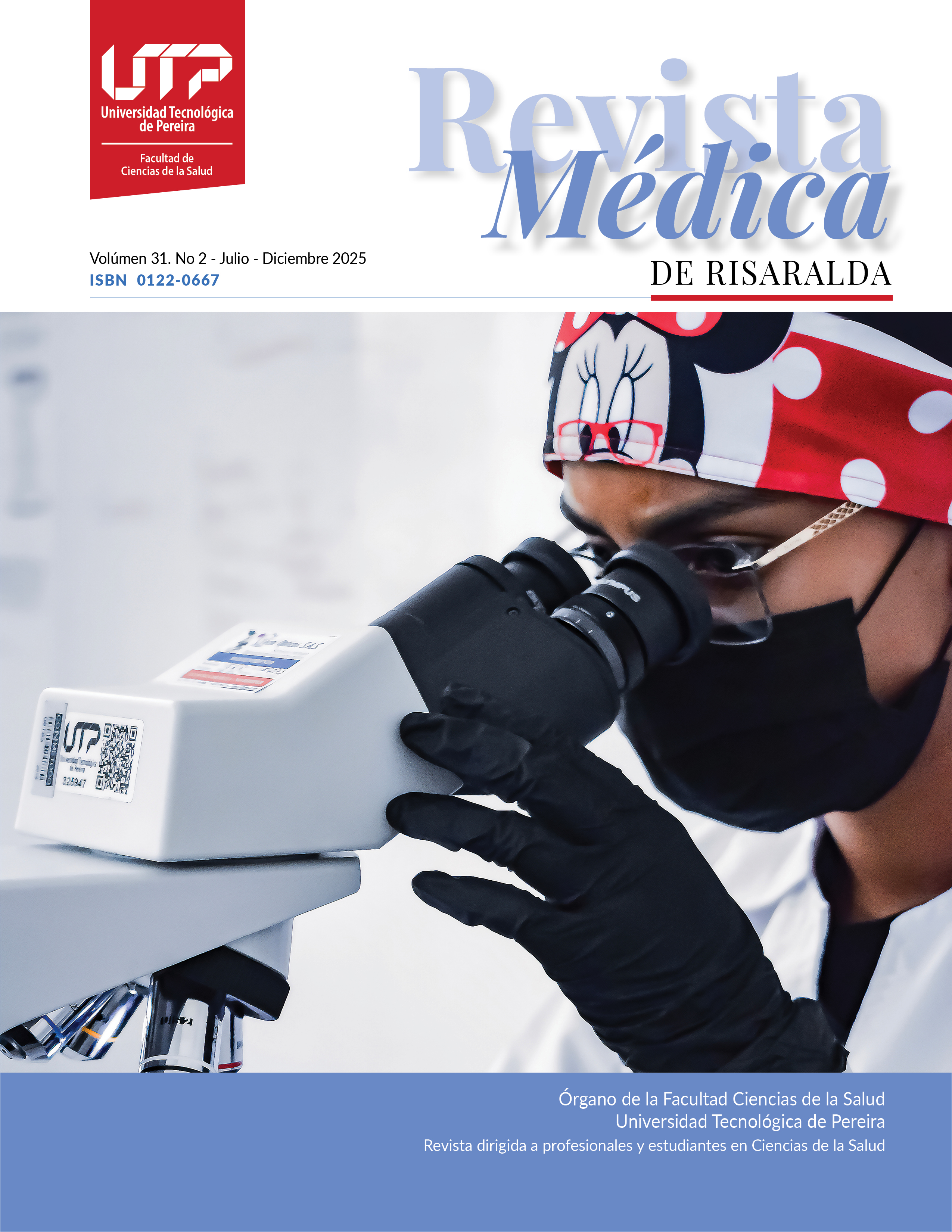Study of Cardiovascular Risk Characterization Using the Globorisk Model in Patients from Northwestern Colombia
DOI:
https://doi.org/10.22517/25395203.25781Keywords:
Cardiovascular risk, Globorisk, Risk factors, Cardiovascular diseases, ColombiaAbstract
Introduction: Cardiovascular diseases represent the leading cause of morbidity and mortality worldwide. Identifying cardiovascular risk in specific populations allows for the timely implementation of intervention strategies. The Globorisk model is a validated tool that estimates the 10-year risk of cardiovascular events, considering clinical and demographic variables.
Objective: To characterize cardiovascular risk using the Globorisk model in patients from northwestern Colombia.
Materials and Methods: A descriptive, cross-sectional study with a quantitative approach was conducted. The population included patients over 40 years of age who attended a healthcare institution in northwestern Colombia. The Globorisk model was applied, estimating cardiovascular risk based on age, sex, blood pressure, total cholesterol, diabetes, and smoking status.
Results: 68.8% of participants were women, with a mean age of 65.67 years. The main comorbidities were arterial hypertension (81.4%), non-insulin-dependent diabetes mellitus (28.2%), and hypercholesterolemia (24.3%). Treatment adherence was 91%, while adequate control of risk factors reached 70.2%. According to Globorisk-based cardiovascular risk estimation, 35.2% of the population had low risk, 46.1% moderate risk, and 18.7% high risk. Patients with higher cardiovascular risk showed lower treatment adherence levels.
Conclusions: The prediction equations applied using the Globorisk model demonstrated good performance in terms of discrimination and calibration, surpassing limitations observed in other models previously used in similar contexts. Furthermore, there is a need to strengthen access for high-risk populations to specialized cardiovascular care, as well as to improve continuity in monitoring and control of risk factors. Based on these findings, the implementation of an institutional improvement plan aimed at strengthening comprehensive cardiovascular risk management is recommended, along with multicenter studies to validate and optimize the application of the Globorisk model and other stratification tools across different regions of Colombia, contributing to improved national cardiovascular prevention strategies.
Downloads
References
Roth GA, Mensah GA, Johnson CO, et al. Global burden of cardiovascular diseases and risk factors, 1990–2019: Update from the GBD 2019 Study. J Am Coll Cardiol. 2020;76(25):2982–3021. doi: 10.1016/j.jacc.2020.11.010.
Prabhakaran D, Anand S, Watkins D, et al. Cardiovascular, respiratory, and related disorders: Key messages from Disease Control Priorities, 3rd edition. Lancet. 2018;391(10126):1224–1236. doi: 10.1016/S0140-6736(17)32471-6.
Lim SS, Gaziano TA, Gakidou E, et al. Prevention of cardiovascular disease in high-risk individuals in low-income and middle-income countries: Health effects and costs. Lancet. 2007;370(9604):2054–2062. doi: 10.1016/S0140-6736(07)61699-7.
Atun R, de Andrade LO, Almeida G, et al. Health System Reform and Universal Health Coverage in Latin America. Lancet. 2015;385(9974):1230–1247. doi: 10.1016/S0140-6736(14)61646-9.
Karmali KN, Persell SD, Perel P, et al. Risk scoring for the primary prevention of cardiovascular disease. Cochrane Database Syst Rev. 2017;3(3):CD006887. doi: 10.1002/14651858.CD006887.pub4.
Damen JA, Hooft L, Schuit E, et al. Prediction models for cardiovascular disease risk in the general population: Systematic review. BMJ. 2016;353:i2416. doi: 10.1136/bmj.i2416.
Hajifathalian K, Ueda P, Lu Y, et al. A novel risk score to predict cardiovascular disease risk in national populations (Globorisk): A pooled analysis of prospective cohorts and health examination surveys. Lancet Diabetes Endocrinol. 2015;3(5):339–355. doi: 10.1016/S2213-8587(15)00081-9.
Ueda P, Woodward M, Lu Y, et al. Laboratory-based and office-based risk scores and charts to predict 10-year risk of cardiovascular disease in 182 countries: A pooled analysis of prospective cohorts and health surveys. Lancet Diabetes Endocrinol. 2017;5(3):196–213. doi: 10.1016/S2213-8587(17)30015-3.
WHO CVD Risk Chart Working Group. World Health Organization cardiovascular disease risk charts: Revised models to estimate risk in 21 global regions. Lancet Glob Health. 2019;7(10):e1332–e1345. doi: 10.1016/S2214-109X(19)30318-3.
Singh GM, Danaei G, Farzadfar F, et al. The age-specific quantitative effects of metabolic risk factors on cardiovascular diseases and diabetes: A pooled analysis. PLoS One. 2013;8(7):e65174. doi: 10.1371/journal.pone.0065174.
Woodward M, Huxley H, Lam TH, et al. A comparison of the associations between risk factors and cardiovascular disease in Asia and Australasia. Eur J Cardiovasc Prev Rehabil. 2005;12(5):484–491. doi: 10.1097/01.hjr.0000170264.84820.8e.
Carrillo-Larco RM, Altez-Fernandez C, Pacheco-Barrios N, et al. Cardiovascular disease prognostic models in Latin America and the Caribbean: A systematic review. Glob Heart. 2019;14(1):81–93. doi: 10.1016/j.gheart.2019.03.001.
Cohorts Consortium of Latin America and the Caribbean (CC-LAC). Cohort profile: The Cohorts Consortium of Latin America and the Caribbean (CC-LAC). Int J Epidemiol. 2020;49(5):1431–1432. doi: 10.1093/ije/dyaa073.
Collins GS, Reitsma JB, Altman DG, Moons KG. Transparent reporting of a multivariable prediction model for individual prognosis or diagnosis (TRIPOD): The TRIPOD statement. Ann Intern Med. 2015;162(1):55–63. doi: 10.7326/M14-0697.
Muñoz VOM, Ruiz Morales ÁJ, Mariño Correa A, Bustos CMM. Concordancia entre los modelos de SCORE y Framingham y las ecuaciones AHA/ACC como evaluadores de riesgo cardiovascular. Rev Colomb Cardiol. 2017;24(2):110–116.
Blümel JE, Carrillo-Larco RM, Vallejo MS, Chedraui P. Multimorbidity in a cohort of middle-aged women: Risk factors and disease clustering. Maturitas. 2020;137:45–49. doi: 10.1016/j.maturitas.2020.04.016.
Tartaglione JE, Grazioli GC, Sarmiento MP, Goldstraj G. Eventos cardiovasculares en una población cerrada: Seguimiento a 10 años. Rev Argent Cardiol. 2008;76:347–351.
Lajous M, Ortiz-Panozo E, Monge A, et al. Cohort profile: The Mexican Teachers’ Cohort (MTC). Int J Epidemiol. 2017;46(2):e10. doi: 10.1093/ije/dyv123.
Denova-Gutiérrez E, Flores YN, Gallegos-Carrillo K, et al. Health workers cohort study: Methods and study design. Salud Publica Mex. 2016;58(6):708–716. doi: 10.21149/spm.v58i6.8299.
Huxley RR, Woodward M. Cigarette smoking as a risk factor for coronary heart disease in women compared with men: A systematic review and meta-analysis of prospective cohort studies. Lancet. 2011;378(9799):1297–1305. doi: 10.1016/S0140-6736(11)60781-2.
Peters SA, Huxley RR, Woodward M. Diabetes as a risk factor for stroke in women compared with men: A systematic review and meta-analysis of 64 cohorts. Lancet. 2014;383(9933):1973–1980. doi: 10.1016/S0140-6736(14)60040-4.
Lawes CM, Bennett DA, Parag V, et al. Blood pressure indices and cardiovascular disease in the Asia Pacific region: A pooled analysis. Hypertension. 2003;42(1):69–75. doi: 10.1161/01.HYP.0000075083.04415.4B.
Lloyd-Jones DM, Braun LT, Ndumele CE, et al. Use of risk assessment tools to guide decision-making in the primary prevention of atherosclerotic cardiovascular disease: A special report from the American Heart Association and American College of Cardiology. Circulation. 2019;139(25):e1162–e1177. doi: 10.1161/CIR.0000000000000638.
GBD 2019 Risk Factors Collaborators. Global burden of 87 risk factors in 204 countries and territories, 1990–2019: A systematic analysis for the Global Burden of Disease Study 2019. Lancet. 2020;396(10258):1223–1249. doi: 10.1016/S0140-6736(20)30752-2.
Yusuf S, Joseph P, Rangarajan S, et al. Modifiable risk factors, cardiovascular disease, and mortality in 155,722 individuals from 21 high-income, middle-income, and low-income countries (PURE): A prospective cohort study. Lancet. 2020;395(10226):795–808. doi: 10.1016/S0140-6736(20)30484-3.
Heron M. Deaths: Leading causes for 2017. Natl Vital Stat Rep. 2019;68(6):1–77.
Organización Panamericana de la Salud (OPS). Enfermedades cardiovasculares [Internet]. OPS; 2023 [citado 2024 Dic 5]. Disponible en: https://www.paho.org/es/temas/enfermedades-cardiovasculares.
Ministerio de Salud y Protección Social (Colombia). Situación de las enfermedades cardiovasculares en Colombia 2022 [Internet]. Bogotá: MSPS; 2022 [citado 2024 Dic 5]. Disponible en: https://www.minsalud.gov.co/
World Health Organization (WHO). Noncommunicable diseases country profiles 2018. Geneva: WHO; 2018. Disponible en: https://www.who.int/publications/i/item/9789241514620
Lamelas P, Diaz R, Orlandini A, et al. Prevalence, awareness, treatment, and control of hypertension in rural and urban communities in Latin American countries. J Hypertens. 2019;37(4):681–688. doi: 10.1097/HJH.0000000000001964.
Ordunez P, Martinez R, Soliz P, et al. Heart attack and stroke mortality in the Americas: Data from 2000 to 2019 and recommendations for prevention and control. Rev Panam Salud Publica. 2022;46:e48. doi: 10.26633/RPSP.2022.48.
Ordunez P, Campbell NRC, Giraldo GP, et al. Scaling up cardiovascular disease prevention in the Americas: The HEARTS in the Americas initiative. Lancet Reg Health Am. 2022;7:100146. doi: 10.1016/j.lana.2022.100146.
United Nations. Transforming our world: The 2030 Agenda for Sustainable Development [Internet]. New York: United Nations; 2015 [citado 2024 Dic 5]. Disponible en: https://sdgs.un.org/2030agenda
Secretaría de Salud de Bogotá. Boletín de enfermedades no transmisibles 2021 [Internet]. Bogotá: SDS; 2021 [citado 2024 Dic 5]. Disponible en: https://www.saludcapital.gov.co/
Ministerio de Salud de Chile. Encuesta Nacional de Salud 2016-2017 [Internet]. Santiago: Gobierno de Chile; 2017 [citado 2024 Dic 5]. Disponible en: https://www.minsal.cl/
Ministerio de Salud y Protección Social (Colombia). Encuesta Nacional de Salud 2015-2016 [Internet]. Bogotá: MSPS; 2016 [citado 2024 dic. 5]. Disponible en: https://www.minsalud.gov.co/
González DC, González NJ, González RG, et al. Factores de riesgo cardiovascular en población urbana colombiana. Rev. Salud Pública. 2021;23(3):e38404. doi: 10.15446/rsap.v23n3.38404.
Morales CA, González JF, Pérez VH, et al. Evaluación del riesgo cardiovascular en población adulta colombiana mediante el modelo Globorisk: Resultados de un estudio piloto. Rev Colomb Cardiol. 2022;29(2):120–127. doi: 10.1016/j.rccar.2021.07.003.
Rodríguez YA, Castañeda LE, Páez MG, et al. Validación externa del modelo Globorisk en población colombiana: Comparación con Framingham y SCORE. Rev Colomb Cardiol. 2020;27(4):238–245. doi: 10.1016/j.rccar.2020.02.002.
WHO. WHO STEPwise approach to surveillance (STEPS) [Internet]. Geneva: World Health Organization; 2021 [citado 2024 Dic 5]. Disponible en: https://www.who.int/teams/noncommunicable-diseases/surveillance/systems-tools/steps
Downloads
-
Vistas(Views): 300
- PDF (Español (España)) Descargas(Downloads): 88
- PDF Descargas(Downloads): 18
Published
How to Cite
Issue
Section
License
Cesión de derechos y tratamiento de datos
La aceptación de un artículo para su publicación en la Revista Médica de Risaralda implica la cesión de los derechos de impresión y reproducción, por cualquier forma y medio, del autor a favor de Facultad de Ciencias de la Salud de la Universidad Tecnológica de Pereira. 1995-2018. Todos los derechos reservados ®
por parte de los autores para obtener el permiso de reproducción de sus contribuciones. La reproducción total o parcial de los trabajos aparecidos en la Revista Médica de Risaralda, debe hacerse citando la procedencia, en caso contrario, se viola los derechos reservados.
Asimismo, se entiende que los conceptos y opiniones expresados en cada trabajo son de la exclusiva responsabilidad del autor, sin responsabilizarse ni solidarizarse, necesariamente, ni la redacción, ni la editorial.
Es responsabilidad de los autores poder proporcionar a los lectores interesados copias de los datos en bruto, manuales de procedimiento, puntuaciones y, en general, material experimental relevante.
Asimismo, la Dirección de la revista garantiza el adecuado tratamiento de los datos de carácter personal



